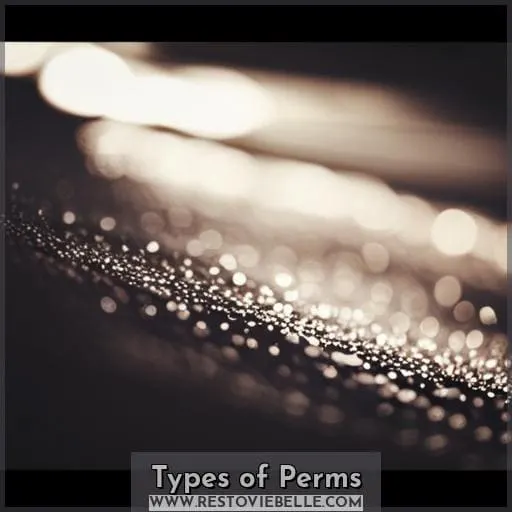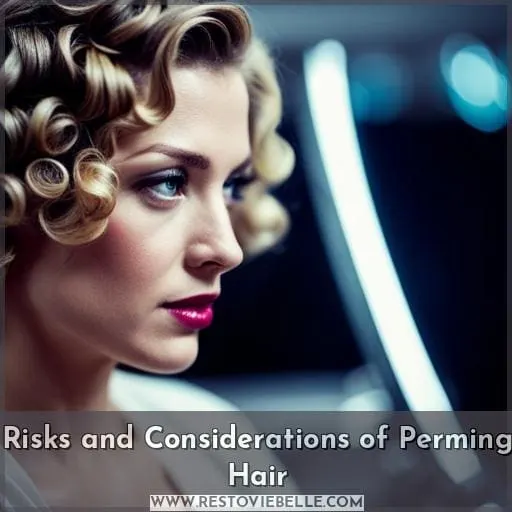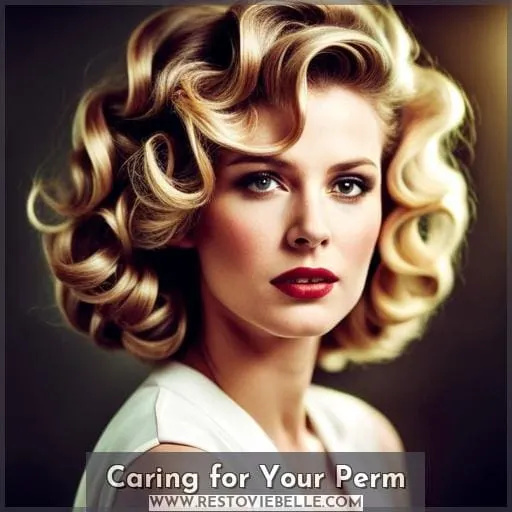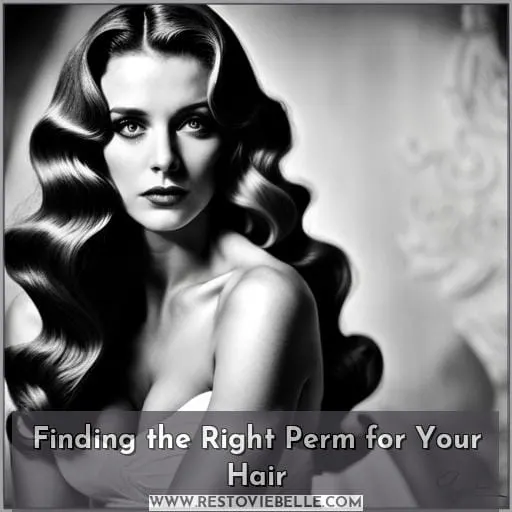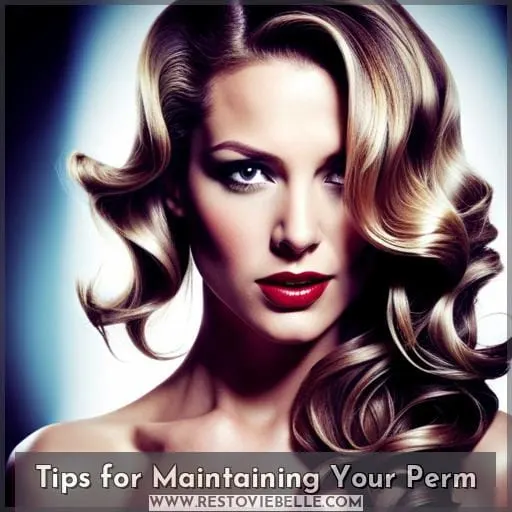This site is supported by our readers. We may earn a commission, at no cost to you, if you purchase through links.
 Ready to transform your hair into a stunning new style? Discover the world of perms and unlock endless possibilities for texture, volume, and shape.
Ready to transform your hair into a stunning new style? Discover the world of perms and unlock endless possibilities for texture, volume, and shape.
In this article, we’ll explore what a perm is and how it works its magic on your locks. We’ll delve into different types of perms available and discuss the risks involved. Plus, you’ll learn essential tips for caring for your gorgeous new curls or waves to ensure they stay fabulous day after day.
Get ready to embrace the power of a perm!
Table Of Contents
Key Takeaways
- Definition of a perm and how it works
- Chemical process involved in perms and how it changes hair structure
- Role of heat in modern perms and achieving desired results
- Use of rods and rollers to create different curl patterns and styles
What is a Perm?
A perm is a chemical treatment that creates curls in your hair. It’s a popular method for adding texture and volume to straight or limp hair.
The perming process involves applying a solution to the hair, which breaks down the structure of the hair shafts. Once the bonds are broken, rods or rollers are used to shape and set the hair into curls.
After some time, another solution is applied to reform new bonds within each strand of hair, locking in the desired curl pattern.
It’s important to understand that not all types of perms are suitable for every individual’s unique needs and preferences. There are various types of perms available, including cold wave perms (using ammonium thioglycolate) and acid-balanced or exothermic perms (requiring heat).
Each type offers different results based on factors such as duration of processing time and level of curl intensity.
While getting a perm can be an exciting way to transform your hairstyle, it’s crucial also consider potential risks associated with this chemical treatment technique. Some common risks include damage caused by over-processing or improper application techniques leading breakage dryness if proper maintenance care isn’t followed after obtaining one.
In order maintain healthy-looking locks post-perm experience longevity tips should be observed regularly like using sulfate- sodium chloride-free shampoo conditioner prevent frizzing protect from sun exposure avoid excessive heat styling tools apply deep conditioning treatments once week minimize any further harm done during these processes ensure lasting effects
Choosing the right stylist and salon conducting thorough consultations beforehand will help determine best approach achieving desired look while minimizing risk overall health wellbeing strands throughout entire journey towards perfect head full bouncy beautiful curls.
How Does a Perm Work?
To understand how a perm works, let’s take a closer look at the chemical process that transforms straight hair into beautiful curls.
- Chemical Process: Perms use chemicals to break down the hair structure and reshape it into curls. The two common chemicals used in perms are ammonium thioglycolate and glyceryl monothioglycolate.
- Hair Structure: The keratin in your hair forms its structure, and perms work by altering this keratin through shape memory.
- Heat Activation: In modern perms, heat is often used to activate the chemical reaction and restructure the hair follicles more effectively.
During a perm treatment, your stylist will wrap sections of your hair around rods or rollers of various sizes depending on the desired curl pattern. After applying the perming solution to each section, heat may be applied for better results.
This allows for customization based on individual preferences and different types of curls.
Modern perms offer more versatility than ever before by allowing you to choose from loose waves or tight spirals that suit your unique style. By understanding how this chemical process works along with roller sizes and heat activation techniques employed in modern perms,you can achieve stunning curly hairstyles that complement any type of natural texture or length.
Now that you know how a perm works chemically let’s explore some popular typesofpermsandtherisks associatedwiththemtohelpyou makeaninformeddecisionaboutyourhaircare journey
Types of Perms
There are various types of perms that can give you the desired curls or waves. When choosing a perm style, it’s important to consider your hair texture and curl patterns.
Modern perms offer different techniques and methods to achieve specific looks. One popular type is the digital perm, which uses heat and special rods to create soft, bouncy curls that last for months. Another option is the ceramic perm, which utilizes ceramic rollers for a more natural-looking wave pattern.
If you’re looking for added volume and body, a styling perm might be right for you as it focuses on creating lift at the roots while keeping the ends smooth.
Once you’ve decided on a type of perm, proper maintenance is crucial in order to keep your curls looking their best. This includes using gentle shampoos specifically formulated for permed hair and avoiding excessive heat styling tools that can cause damage.
During the perming process itself, it’s important to work with an experienced stylist who understands how each technique works with different hair types.The overall goal should be achieving beautiful results without compromising your hair health.
Risks and Considerations of Perming Hair
When considering perming your hair, it’s important to be aware of the potential risks and considerations.
Perms can potentially damage hair over time, leading to hair loss if scalp health is neglected.
It’s crucial to get perms from trusted salons with skilled professionals who understand how to properly use perm chemicals and minimize the risk of skin irritation, breakage, or other adverse effects.
Additionally, studies suggest that younger individuals may face increased risks associated with perming their hair.
Potential hair damage
When considering the risks and considerations of perming hair, it’s important to be aware of the potential for hair damage.
Perms involve chemical treatments that can weaken the structure of your hair over time, leading to breakage and even hair loss if proper care isn’t taken.
To prevent damage, prioritize scalp care by using gentle products and avoiding harsh chemicals.
Regular maintenance such as deep conditioning treatments and trimming split ends will help maintain healthy hair throughout the duration of your perm.
Importance of professional salon
When considering perming your hair, it’s essential to prioritize the importance of visiting a professional salon.
- Salon importance: Professional salons have trained and experienced stylists who specialize in perms. They’ve the expertise and knowledge to assess your hair health, determine the right perm type for you, and provide expert guidance throughout the process.
- Hair health: Perming can be damaging if not done correctly or with proper care afterward. Professional stylists know how to minimize damage by using quality products, performing deep conditioning treatments, and recommending sulfate-free shampoos for maintenance.
- Styling options: A professional salon can offer a wide range of styling options beyond just traditional perms – from loose waves to spiral curls or even customized looks based on your preferences and face shape. Their expertise ensures that you achieve beautiful results while maintaining healthy hair.
Risks for young individuals
If you’re a young individual considering getting a perm, it’s essential to be aware of the potential risks and considerations associated with perming your hair.
While perms can be a great way to change your look, there are some risks involved. Young individuals may have more delicate hair that’s prone to damage. It’s important to prioritize hair health and consult with professionals who specialize in perm safety for teenagers.
Proper care and maintenance are crucial for minimizing the risk of hair damage from perms.
Caring for Your Perm
Now that you’re aware of the risks and considerations involved in perming your hair, it’s time to delve into caring for your perm. Proper maintenance is crucial to keep your curls looking their best and ensure the longevity of your perm.
- Use gentle products: Invest in hair care products specifically designed for permed hair. Look for sulfate-free shampoos and conditioners that won’t strip away moisture or disrupt the chemical bonds of your curls.
- Avoid common mistakes: Steer clear of excessive heat styling, as high temperatures can damage the structure of your curls over time. Opting for air-drying or using diffusers on low heat settings will help preserve the integrity of each curl.
- Treat with protein: Perms involve breaking down keratin proteins in order to reshape them into new curl patterns, so replenishing those proteins is essential post-perm care! Regular protein treatments can strengthen and nourish chemically-treated strands, preventing breakage and maintaining elasticity.
Finding the Right Perm for Your Hair
To find the perfect perm for your hair, consider consulting with a trusted hairstylist who can recommend a perm type that suits your unique hair texture and desired style.
They’ll take into account factors such as your hair length, compatibility with different types of perms, and any previous chemical treatments like dyed or chemically treated hair. Communicate your style preferences clearly to ensure you achieve the desired look.
During the consultation process, don’t hesitate to ask questions about different types of perms and their effects on your specific hair type. Your stylist can guide you through various options including body perms for added volume, spot perms for specific sections of the head, or root perms for more overall body.
Additionally, it’s important to discuss care tips with your stylist in order to maintain longevity after getting a perm. They may provide product recommendations specifically tailored to permed hairstyles that will help keep curls intact while minimizing damage.
By working closely with a professional hairstylist who understands both styling techniques and proper care practices post-perm treatment is key in achieving optimal results from this transformative hairstyle option.
Tips for Maintaining Your Perm
To maintain your perm, follow these tips for keeping your curls looking their best:
- Use sulfate-free and gentle shampoos.
- Avoid excessive heat styling.
- Protect your hair while sleeping.
By following these simple tips, you’ll be able to maintain the health of your perm while enjoying beautiful curls that last longer.
Additional information:
Proper care is essential in maintaining the longevity of any hairstyle – including perms! By taking certain precautions and adopting specific styling habits after getting a permanent wave treatment at a salon near you; it’s possible not only will this keep them looking fresh but also prevent potential long-term risks associated with damaging one’s own strands through neglectful practices such as over-styling without protection applied beforehand (or even during).
[IMAGE]
Frequently Asked Questions (FAQs)
Can I perm my hair if it’s been previously dyed or chemically treated?
Yes, you can perm your hair if it has been previously dyed or chemically treated. However, it’s important to consult with a professional stylist to assess the condition of your hair and ensure proper preparation and care for the best results.
How long does the perm process take?
The perm process typically takes around 2 to 4 hours, depending on the length and thickness of your hair.
- Consultation
- Application of chemicals and rollers
- Processing time
- Rinsing
- Styling
Can I swim or go to the beach with a perm?
Yes, you can swim or go to the beach with a perm.
However, it’s important to protect your hair from chlorine and saltwater by wearing a swim cap or applying leave-in conditioner before swimming.
Can I style my permed hair with heat tools?
Yes, you can style your permed hair with heat tools. However, it’s important to use them sparingly and at lower temperatures to avoid damaging the curls. Remember, excessive heat can cause your perm to lose its shape faster than usual.
What are some alternatives to getting a perm for adding curls or waves to my hair?
To add curls or waves to your hair without getting a perm, you can try using heat tools like curling irons or hot rollers.
You can also experiment with different styling techniques such as braiding or twisting damp hair and letting it air dry for natural texture.
Conclusion
To sum it up, a perm is a fantastic way to transform your hair and add texture, volume, and shape.
With different types of perms available, you can choose the style that suits you best.
However, it’s important to consider the risks involved, such as potential hair damage and the need for a professional salon.
Regardless, with proper care and maintenance, your perm can stay fabulous day after day.
So go ahead and embrace the power of a perm to unleash a stunning new style.

